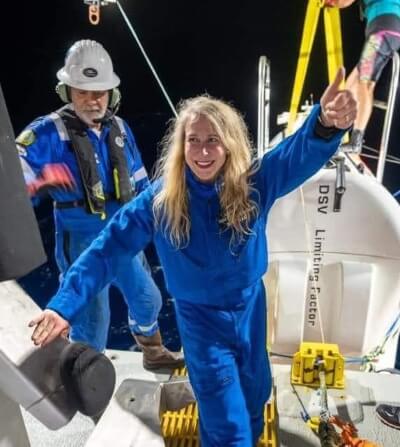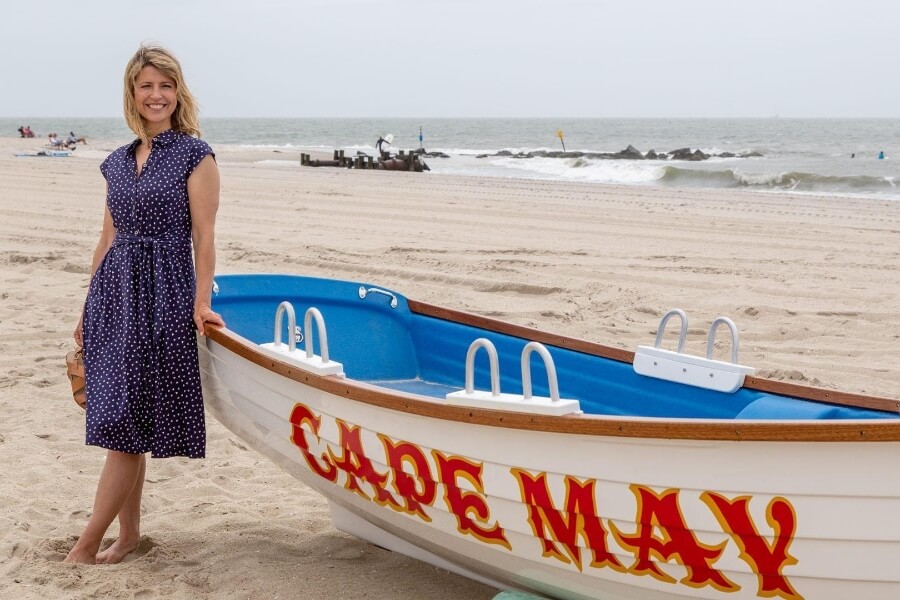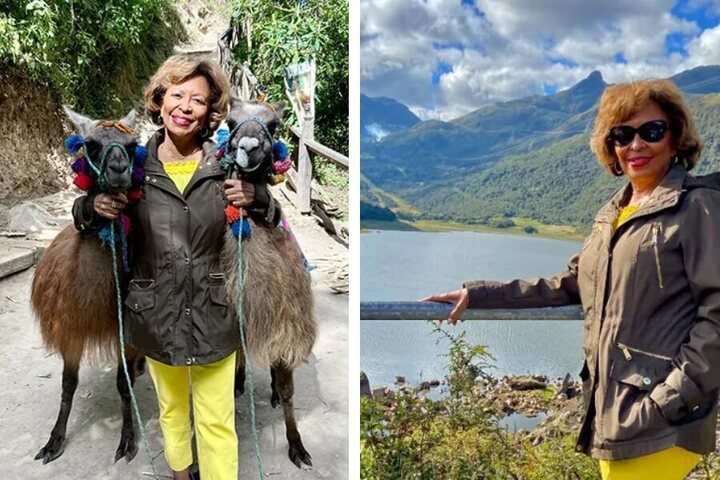Editor’s note: The economic meltdown of 2008 crushed Vanessa O’Brien’s high-flying career in finance, prompting her to search for new purpose in her life. She started a list of possible projects that fit five criteria: Clearly defined goal, measurable success, could be accomplished in two to three years, audacious and challenging, and nothing to do with finance. She ultimately decided to set her sights on the summit of Mt. Everest. After taking a mountaineering course in New Zealand and a practice run to Camp 2 on Everest (not the summit), that didn’t go well for her, she tried climbing the almost 27,000-feet mountain in Tibet called Cho Oyu with a guiding service, but an avalanche prevented her team from reaching their goal. Here, she picks up the story after the disappointment in Tibet.
Excerpted from To the Greatest Heights, published by Atria Books, a division of Simon & Schuster, Inc. Copyright © 2021 by Vanessa O’Brien. Photo above is of O’Brien on the summit of K2.
***
“Your climbing is pretty good,” our guide Daniel said, as we departed Cho Oyu, the sixth tallest mountain, earlier than planned due to avalanche risk. “You should think about Everest.”
He wasn’t talking to me.
Want to hear more about Vanessa O’Brien? Join us for a chat on Thursday, May 6th. Click here to save your spot for this free event.
I sat in a tepid stew of disappointment spiced with a few red pepper flakes of jealousy while Daniel and the Australian policeman who was part of the team launched into an animated conversation about making Everest happen. Why him and not me? I wondered, and not in a bitter rhetorical sense. I seriously wanted to know what it was that Daniel saw as the tipping point, the nuts-and-bolts difference between this guy’s dream and my pipe dream.
His response was good-natured: “So you really want to climb Everest? All right, then. Here’s what you need to do.” Daniel laid out a straightforward list of things he recommended to optimize my body and prepare my mind, an estimate of what I’d have to invest in the endeavor, plus a list of mountains I should consider climbing before I tried Everest again.
How to Get to Mt. Everest
Daniel connected me with a guide named Craig John who took me up Mt. Washington in New Hampshire. Later, in Washington state, I saw Craig again.
“Are you leading the Kautz Glacier team on Mt. Rainer?” I asked Craig.
“No, that’s Jessica,” he said, “but I’ll be able to check in with you on the radio.
“Jessica?” Okay, it’s not like a griffin flew over and landed on the picnic table next to us, but she was the first female guide I encountered, and I was curious. In my experience women make great leaders. End of story. And this woman was especially fierce, physically strong, and technically proficient. I would witness her in action as she fixed ropes, balanced on the the steep glacier. She and her three male assistants would facilitate eight climbers: five American men, an Italian guy, an American woman named Ruth, and me.
Read More: You Can Do It. Even Now. Getting in the Best Shape of Your Life After 50
Managing Expectations

Protocol on Rainier is to divvy up group gear to transport food and accoutrements while keeping everyone’s pack under fifty pounds. It’s a double-edged sword, this group gear distribution, because at some point, the law of diminishing returns kicks in and the marginal weight of food or tents for one additional climber should be negligible, whereas the cost savings should be higher, because you’ve also got more people sharing that burden. I was hoping the climbing company knew what that number was and that it was within our team dynamics.
Ruth arrived with no alpine gear, needing to rent everything, while the rest of us had arrived pretty kitted out. I was strong after all my training and didn’t mind toting the proverbial barge. Ruth showed up a little late, so there was only one piece of group gear left: a giant lobster pot filled with food. The others looked at me, and then looked at Ruth—who is also all of five foot four—and then side-eyed this enormous pot. What we didn’t know was that Ruth was an army major, director of skull base surgery at Walter Reed Army Medical Center. She could build a tent and perform head and neck surgery inside it. That pot was probably half her body weight, but she picked it up like she didn’t give a damn, and we set off for the park entrance.
We were looking at four and a half days to complete the climb. Jessica managed expectations from the start. “No one has summited from this route this season,” she said. “We’re likely to see deep snow and high winds.” I’d done my homework. According to the National Park Service, between 2006 and 2010, an average of 381 climbers attempted the Kautz Glacier route every year. The success rate as of 2010 was only 60 percent—and that was in an average year with moderate snow and wind.
Starting the Climb
The first day, we crossed open alpine meadows of fragrant grass, but within a few hours, we were breaking trail through the snow fields and crossing the Nisqually Glacier, making slow but steady progress to our first campsite at 7,000 feet. Ruth and I were sharing a tent, and she had that thing upright and tight as a drumhead in minutes while I shoveled snow to level our campsite and stomped it flat.
We pushed through the snow drifts, step by laborious step, up to High Camp.
“They can load me down physically, but they will never beat me mentally.” She tapped her temple. “Everything I need to win is up here.”
“Copy that, Major.” I offered a fist bump, and we tucked ourselves into our sleeping bags.
The next day, we pushed through the drifts, step by laborious step, up to High Camp at 10,000 feet. The snow was over our knees now, and half the group was fairly knackered. After building our camp, we stood for a while, looking out at the distant vista. The spectacular view was worth the painful price. We were above a thick cotton-batting layer of clouds. The sinking sun created a prism of blue, yellow, and orange and ignited every ice particle on the mountain.
As we settled into High Camp, Jessica motioned for our attention. “Listen, everyone,” Jessica said, “I have good news and bad news, and we have a decision to make. The weather is on our side, but the fact is, we’re moving too slow to make the summit tomorrow. So, I need a decision. Do you want to see how far we can make it as a group? Or do some of you want to stay here and allow others to go for a summit push?”
I looked around the circle. No one met my eyes. No one wanted to be the first to chime in.
To the Summit…or Not
“I’d like to see someone summit,” I said. “I’d like to see even a few of us get there—break this season of no summits— rather than have all of us climb a little higher, which doesn’t buy any summits for anyone.” I tried to laugh instead of cough. “Kind of an old-school Everest approach in the spirit of Tenzing and Hillary. Just get someone up there, right?”
For a moment, there was only the sound of the wind. A few others chimed in with a tepid, “Hey, we’re all in this together,” but the majority of voices were aligned with my way of thinking. “Okay.” Jessica looked around the circle, not naming any names. Instead of asking for volunteers to stay behind, she asked, “Knowing tomorrow is the hardest day, who feels like you’ve got it in you to keep up the pace we have to maintain in order to summit?”
Ruth and I immediately raised our hands. The Italian raised his hand, followed by one of the Americans. That was it. Jessica waited, studying each face, meeting every eye. She wasn’t making it easy. “All right, then,” she said. “You four will come with me and a guide to the summit tomorrow morning. The rest will stay here with a guide until we return, and we’ll descend as a team.”
Female Leadership

This is the difference between typical male leadership and—that rarest of unicorns—a woman in charge of an endeavor traditionally dominated by men. In my experience, a male guide would have taken one of two approaches: A) cautious: “We’re moving too slow to summit. We’re all going down.” Or B) authoritative: “You, you, and you are going too slow. You’re staying behind. Everyone else, prepare to summit.” If a woman said the same words in the same tone of voice, people would say she was A) weak or B) a bitch. Jessica’s soft-skills approach—a two-way discussion that challenged us to be our best selves and come to an egalitarian decision as a group—was an example of how female leadership is often more collaborative and communicative.
Struggling to stay upright, Ruth and I clung to each other, grinning inside our buffs.
That night, the wind was a relentless scold. We had to use our ice axes to secure our tents. After sleeping on it—what little sleep there was—the American guy had a change of heart. He swallowed his pride and stayed at the camp as Jessica and the last remnant of the team waded into the deep snow to access the Kautz Glacier and headed up, bracing ourselves against the “windy summit” dynamic that formed a shrieking vortex at the peak.
Struggling to stay upright, Ruth and I clung to each other, grinning inside our buffs. The morning sun lit the silver sweep of ice below and the Cascade mountain range around us. Old volcanoes cast looming shadows that made the valleys look dark and wet. It was cold and quiet down there, the antithesis of all the fire and pandemonium that created this place.
Back at camp that night, I recorded on my iPhone: Mt. Ranier Kautz Glacier, 14,410 feet, summit at 11:30 AM June 16, 2011.
My first active volcano. My first climb with group gear and a female guide. I didn’t have the poetry to explain the sacredness of this mountain, and I was too sleepy to force my stiff fingers to write down any more details. My mind was already on the Himalayas.
Read More: My Answer to a Frustrating, Demoralizing Search for a New Job? Go Climb a Mountain





















0 Comments